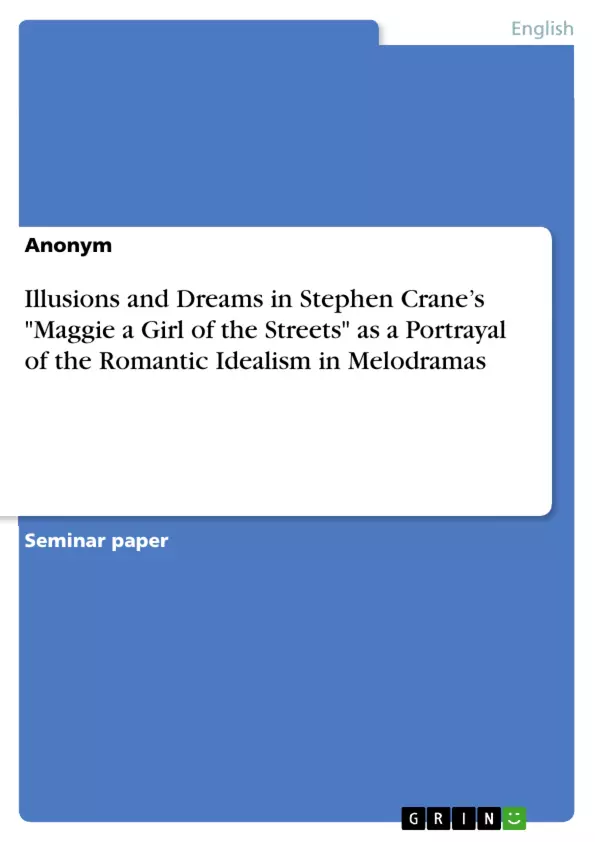This term paper deals with the book "Maggie a Girl of the Streets" by Stephen Crane. In the middle of the 19th century a new type of literature emerged from the prior romanticist novellas. Authors wanted to present life more realistically than it had been portrayed before, separating from romanticist literature which to them did not seem to portray life in an adequate manner. Therefore, the concepts of "Realism" and "Naturalism" were introduced whose followers tried to portray life as it actually was. The book "Maggie a Girl of the Streets" by Stephen Crane is often considered a naturalist story which appears to fulfil the aspect of portraying life in a realistic way.
It deals with the struggles of existence in lower class society, which is a typical feature of naturalist stories. However, Crane often confronts the reader with illusions and dreams of the characters in his book, which seems to contradict the notion of a realist story. Thus, it is questionable if Crane’s Maggie can really be considered a naturalist work. It is therefore interesting to find out what purpose the illusions and dreams in Crane’s book have, as it does not appear to be coincidental that they run throughout the whole story. Furthermore the question arises why "Maggie a Girl of the Streets" can nevertheless be considered a realist piece of work.
This term paper argues that Crane uses the devices of illusions and ideals in Maggie as a medium to satirise the romantic melodrama along with its sentimentalism, since it strongly simplifies reality. By means of this thesis first Crane’s exaggerated descriptions of fighting scenes are portrayed, which shall serve as a proof for Crane’s melodramatic allusions, followed by Maggie’s blurred depiction of Pete as the ideal man. Finally it is illustrated how the theatre shows, which contain melodramatic elements, appear to work as a parallelism to Maggie’s story.
Inhaltsverzeichnis (Table of Contents)
- Introduction
- Exaggeration of fighting scenes
- Pete as a critique on the melodramatic idealism and sentimentalism
- The theatre shows as a melodramatic parallelism to Maggie's story...
- Conclusion
Zielsetzung und Themenschwerpunkte (Objectives and Key Themes)
This text explores how Stephen Crane's Maggie: A Girl of the Streets utilizes elements of romantic melodrama to satirize its idealistic and sentimental nature. By examining the illusions and dreams of the characters, particularly Maggie's perception of Pete, the author aims to analyze how Crane juxtaposes these idealized portrayals with the harsh realities of lower-class society.
- The use of melodrama in Maggie as a tool for satire.
- The contrast between illusion and reality in the lives of the characters.
- The portrayal of romantic idealism and its impact on Maggie's fate.
- The critique of sentimentalism and its limitations in representing the complexity of human experiences.
- The role of social class and poverty in shaping individual destinies.
Zusammenfassung der Kapitel (Chapter Summaries)
- Introduction: The introduction sets the stage by discussing the emergence of realism and naturalism in 19th-century literature and exploring how Maggie, while often considered a naturalist work, incorporates elements of romantic melodrama.
- Exaggeration of Fighting Scenes: This chapter analyzes the portrayal of violence in Maggie, arguing that Crane utilizes exaggerated descriptions of fighting scenes to satirize the heroic tropes common in melodrama. The examples provided include Jimmie's fight for "honor" and his later rebellion against society, highlighting the disparity between the characters' romanticized perceptions of themselves and the reality of their lives.
- Pete as a Critique on the Melodramatic Idealism and Sentimentalism: This section focuses on Maggie's idealized view of Pete, who embodies the romantic hero figure. The chapter explores how Maggie's dreams and hopes are ultimately shattered by Pete's rejection, revealing the artificiality of melodramatic ideals and the harsh realities of life.
Schlüsselwörter (Keywords)
The text focuses on key terms and concepts such as romantic melodrama, realism, naturalism, satire, illusion, reality, idealism, sentimentalism, social class, poverty, and the portrayal of characters like Maggie and Pete.
- Quote paper
- Anonym (Author), 2016, Illusions and Dreams in Stephen Crane’s "Maggie a Girl of the Streets" as a Portrayal of the Romantic Idealism in Melodramas, Munich, GRIN Verlag, https://www.hausarbeiten.de/document/497565


